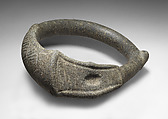Ceremonial collar or belt
Not on view
Stone ring-like collars are most likely part of an assemblage of works that served as regalia that affirmed and projected the political power of Taíno chieftains (caciques) during public and private ceremonies (Oliver 2009; Walker 1993). (Taíno is the name used to refer to the diverse societies that inhabited the Antilles archipelago before European contact.) These stone collars, worn as sashes or bandoliers, together with three-pointed stones (e.g. MMA 1997.35.2) could have conveyed multiple meanings, associating the caciques with zemís (also spelled cemí), a Taíno term related linguistically to a quality akin to sweetness. Zemí refers not to an object or image but to an immaterial, spiritual, and vital force pertaining to deities and ancestors.
This stone collar in the shape of a slender ring was probably crafted between 1000 and 1495, but the tradition seems to originate a few centuries earlier. Carved from a single stone and carefully polished, one end is broadened into two panels arranged in a V-shape with a curved edge. One panel is decorated with a circular depression, while the other frames a herringbone pattern, perhaps an abstract version of a fish motif. On the opposite end, a small tubular projection resembles a belt strap. This slender collar with decorated panels could be a later variation of earlier, heavier rings with “bench” type decoration (see MMA 1984.519.1).
The crafting of these stone objects was demanding. Only a dozen of these were completed per generation, probably commissioned by newly installed caciques (Olivier 2009: 80). Archaeological investigations suggest that many of these stone collars were made at Caguana (Puerto Rico) or its vicinity (Oliver 2009: 126-127). Unfinished and broken specimens have been found in ancient Taíno farmsteads. It is notable that none of the stone collars were reportedly found with funerary remains, suggesting that these potent works of sculpture were inherited by the descendants of the original caretaker, rather than being buried with the deceased.
Due to rights restrictions, this image cannot be enlarged, viewed at full screen, or downloaded.

